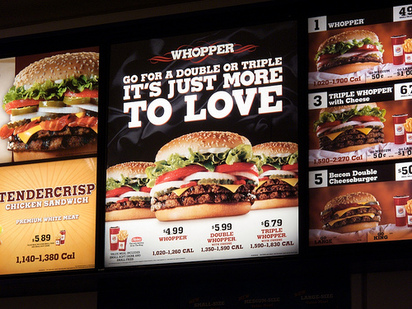 by Jason Block, MD, MPH This post will also be posted on the Eperspective blog from the Institute of Food Technologists. The long-awaited final regulations for calorie labeling were released on December 1, 2014. These regulations come 4+ years after the law requiring them passed, as part of the Affordable Care Act. The regulatory verdict from the US Food and Drug Administration is clear: Calories will be everywhere. Nearly all chain food establishments that sell “restaurant-type food” and have 20 or more sites nationally will have to post calories on their menus. Despite early signals that some food establishments might be exempt, the final regulations state that fast-food restaurants, full-service restaurants, cafeterias, grocery stores, movie theaters, bakeries, convenience stores, vending machine operators, and yes, bowling alleys must comply. Schools are pretty much the only entities that aren’t included. The regulations give establishments until December 2015 to post calories; vending machine operators have until December 2016. The regulations apply to “restaurant-type food”, defined as “foods that are usually eaten on the premises, while walking away, or soon after arriving at another location.” A food establishment doesn’t even need a menu; as long as they sell these foods, they have to create calorie labels for their products. The regulations contrast “restaurant-type food” with food not under the purview of the law – “foods that are grocery-type items that consumers often store for use at a later time or customarily further prepare.” These include, for example, birthday cakes, loaves of bread, and nuts in bins as well as items that aren’t self-service and sold by weight (e.g. deli salads) and those that require further processing (e.g. deli meats). For “restaurant-type food”, only temporary items are exempted, meaning those that are on menus for less than 60 days during a year. The new regulations also don’t cover packaged foods/drinks. As directed by the Nutrition Labeling and Education Act of 1990, these items already have Nutrition Facts panel on them. They will not have to change their package labels as the result of this law (unrelated to the calorie labeling law, the Nutrition Facts panel is in the process of a makeover). How dietary choices might change as a result of these regulations Several municipalities, including New York City, Philadelphia, and Seattle, implemented calorie labeling years ago. Their experiences have provided preliminary insight into whether calorie labeling might work to change what people buy and eat. As a colleague and I recently discussed in a commentary, evaluations of calorie labeling show mixed results. One large study of Starbucks purchases found a 6% reduction in calories after calorie labeling in New York City (compared to Starbucks in Boston and Philadelphia, prior to calorie labeling). Two studies in New York City either found no effect from calorie labeling or a small effect in a few restaurant chains. A recent review examined all scientific studies on calorie labeling and concluded that labeling works best when calorie counts are put into context, such as providing both calorie labels on items and statements on menus describing recommended total daily calorie requirements. This is good news for the federal labeling law. The new regulations will require food establishments to include such a statement on menus.
Overall, prior research suggests that changes in consumer choices from labeling may be small, if they change at all. This isn’t particularly surprising. Consumers are bombarded with advertising, aromas, and decisions when they walk into a food establishment. The calorie labels will be prominent, displayed similarly to the price, but other decisions may be more important, such as the taste and price of items. Some consumers might respond readily to the labels, and others might not even notice them. But, any changes, even small ones, could have large effects across the US population. Perhaps most important are responses of food establishments and their suppliers. Establishments might reformulate their products to keep the calorie numbers down. We’re already seeing some evidence for this in Seattle, after their labeling law. Perhaps in anticipation of calorie labels, or just as a response to market demands for healthier restaurant food, new menu items being introduced in restaurants are lower calorie than older items. These changes are critical because they do not require consumers to make active choices; foods are lower calorie by default. The widespread posting of calories also may bring greater transparency to the concept of calories, helping consumers to better estimate the calories in foods, a task that has been difficult for most of us. After 4.5 years waiting for the regulations, the final verdict on calorie labeling may be right around the corner.
0 Comments
Your comment will be posted after it is approved.
Leave a Reply. |
©2017 WeighingInBlog. All rights reserved. 401 Park Drive, Boston, MA




 RSS Feed
RSS Feed

